How Insurers Can Benefit from Capital-Efficient Emerging Market Debt Investing

Vladimir Zdorovenin, PhD
Head of International Insurance Solutions

Keong Kim
Trader, Global Emerging Markets Fixed Income

Luke Codrington
Co-Head of EM Global Fixed Income
Capital-efficient portfolio construction improves expected portfolio performance for insurers. Insurers are required to hold regulatory capital against the market risk of their investments. By explicitly incorporating these regulatory capital requirements into the construction of a portfolio of hard-currency investment-grade emerging market corporate bonds, we increase the expected return on required capital relative to the benchmark by 1.6x-3.1x – whether by increasing the portfolio spread or reducing the capital requirement, or both.
Broader opportunity sets create better opportunities. Replacing a rigid investment-grade-only requirement with a risk-based capital budget results in a significant improvement in expected portfolio performance with no additional risk (as measured by the risk-based capital requirement).
One size does not fit all. We consider portfolio construction under European Economic Area (EEA) and UK Solvency II, global IAIS Insurance Capital Standard (ICS), Hong Kong Risk-Based Capital (draft), and Australian Life and General Insurance Capital Standards (LAGIC). Our model portfolios show a significant improvement in expected performance under all regimes. The variation in capital-efficient portfolio composition across regimes is significant, providing strong support for insurers favouring bespoke emerging market debt portfolios over off-the-shelf solutions.
Quantitative portfolio construction should support active decision-making, but not replace it. Our capital-efficient portfolios combine our active, forward-looking views and judgement-based concentrations with a numerical portfolio optimizer. While this approach can be applied to all fixed income investments, we believe it is more powerful for the more heterogeneous opportunity sets, such as emerging market corporate debt.

Incorporating regulatory capital requirements into fixed income portfolio construction may improve portfolio performance for insurers in compelling ways – and replacing strict credit quality requirements with a risk-based capital budget can expand the investment opportunity set without adding risk. Our model portfolios of hard-currency investment-grade emerging market (EM) corporate bonds show a significant improvement in expected performance over the benchmark1 across various risk-based capital (RBC) regimes in Europe and Asia-Pacific. Adding a portion of high-yield debt further improves potential results. The significant variation in capital-efficient portfolio composition across the RBC regimes underscores the benefits of tailored EM debt portfolios versus off-the-shelf solutions. In what follows, we explain our model portfolio construction process and the potential benefits for insurers.
Our portfolio construction process
We construct capital-efficient portfolios of hard-currency emerging market debt under four insurance risk-based capital (RBC) regimes from across Europe and Asia-Pacific:
Solvency II regime for UK and EEA insurers
International Association of Insurance Supervisors (IAIS) Insurance Capital Standard (ICS) for Internationally Active Insurance Groups (IAIGs), which underpins several new and emerging risk-based capital regimes in APAC2
Life and General Insurance Capital (LAGIC) framework for Australian life and general insurers3
Hong Kong RBC4
For each regime, we construct two capital-efficient portfolios:
A spread-maximizing portfolio (“max OAS”) that seeks the highest increase in option-adjusted spread over the benchmark for the same risk-based capital requirement
A capital-saving portfolio (“min RBC”) that seeks the lowest RBC while maintaining the portfolio spread at the same level as the benchmark
Under each capital regime, the risk-based capital requirement for a hard-currency corporate bond is determined by the credit rating and effective spread duration.5 At the same time, bond spreads are driven by fundamental, technical, and quantitative factors specific to the instrument, issuer, sector, country, or region. The greater the variation in these factors, the better the opportunity to aim for a higher return on capital by maximizing the portfolio spread for a given capital budget or by minimizing the capital requirement for a target level of portfolio yield or spread.
Capital-efficient portfolios are constructed to be fully investible and reflect our forward-looking views as of the time of the analysis as well as regime-specific capital efficiency considerations. They incorporate issuer and country concentration constraints as well as the Relative Value Ranking, Credit Trend, and ESG Trend recommendations of the PineBridge Investments EM corporate analyst team. In effect, each portfolio is based solely on our credit coverage and recommendations. The capital-efficient portfolios are benchmarked against the JPMorgan CEMBI Broad Diversified Investment Grade Index.
While we use numerical optimization in the portfolio construction process, we do not advocate for a fully mechanical, quantitative-only approach. The starting point of our investment process is the forward-looking views of our in-house credit analysts and our assessment of issuer, country, and sector risk, which determines portfolio risk limits. We use quantitative methods to distill these views and judgments into actionable portfolios that meet a variety of overlapping constraints – not to eliminate human expertise and active decision-making from the portfolio construction and management process.
Capital-efficient portfolio construction increases spreads and reduces capital requirements
For insurers seeking above-benchmark returns without committing additional capital resources, active security selection can generate an additional 42 to 45 basis points of spread for the same capital requirement as the benchmark. For those seeking to free up capital, capital-efficient security selection can more than halve the capital requirement relative to the benchmark.
Spread-maximizing portfolios are constructed by shortening the duration of the portfolio by around 0.7-0.8 years, incorporating off-benchmark positions in quasi-government bonds, and allocating to instruments offering the possibility of an attractive return on capital within the limits set by the portfolio manager. This can result in a 5%-7% increase in the expected spread return on required capital at the cost of a one-notch decrease in average portfolio credit quality (or a two-notch decrease for IAIS ICS). These results are consistent across the four risk-based capital regimes considered.
Capital-saving portfolios carry less than 0.5 times the capital requirement relative to the benchmark, while improving portfolio credit quality by one or two notches. This is achieved by identifying capital-efficient instruments and positioning the portfolio significantly shorter than the benchmark (by 2.4-3.7 years, depending on the capital regime) – something that a broad investor base may find appealing in an environment of volatile and rising interest rates and an inverted US dollar yield curve. The net result is a compelling 1.6x-3.1x increase in expected return on required capital.
The two sets of portfolios sit at opposite ends of a range of capital-efficient outcomes. Insurance investors would typically seek a trade-off between portfolio spread (or yield) and required capital that is somewhere in between, while incorporating numerous additional considerations, such as portfolio liquidity, sustainability and ESG metrics, rating agency capital, or ALM requirements. A real-world application of capital-efficient portfolio construction is an iterative exercise in quantifying the trade-offs between these multiple considerations and incorporating them as additional constraints or objectives in the security selection process, aided by numerical optimization and in close communication between the insurance client and the specialist asset manager.
Figure 1: Capital-Efficient Hard-Currency Investment-Grade EM Debt Portfolio Spread and Return on Risk-Based Capital vs. Benchmark
Solvency II
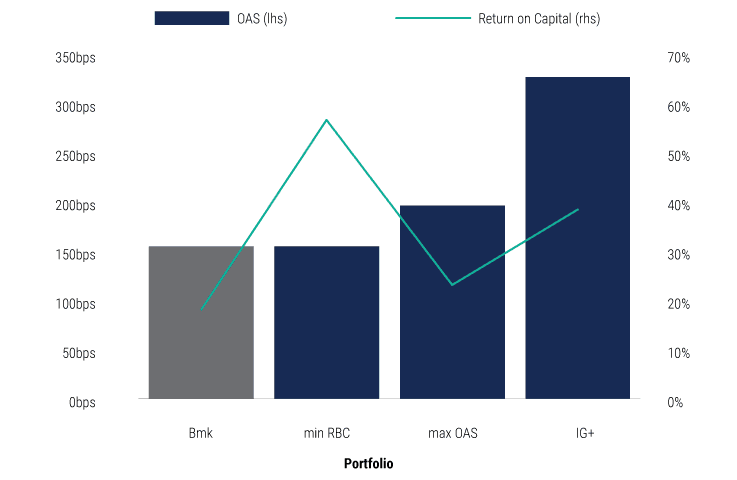
IAIS ICS
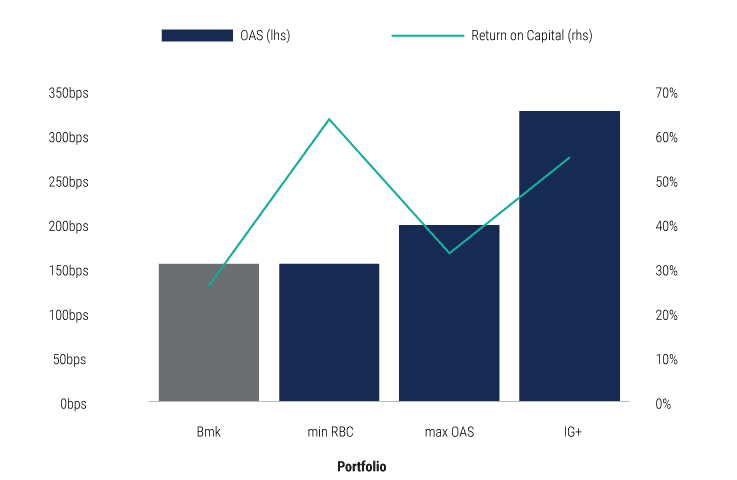
IAIS ICS
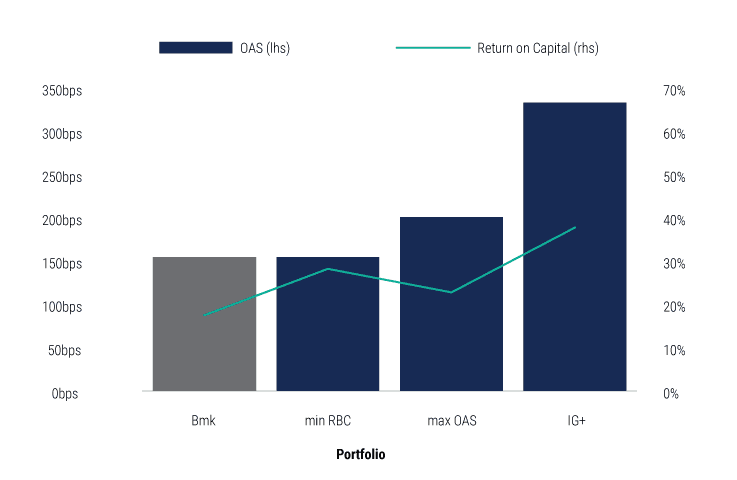
Hong Kong RBC
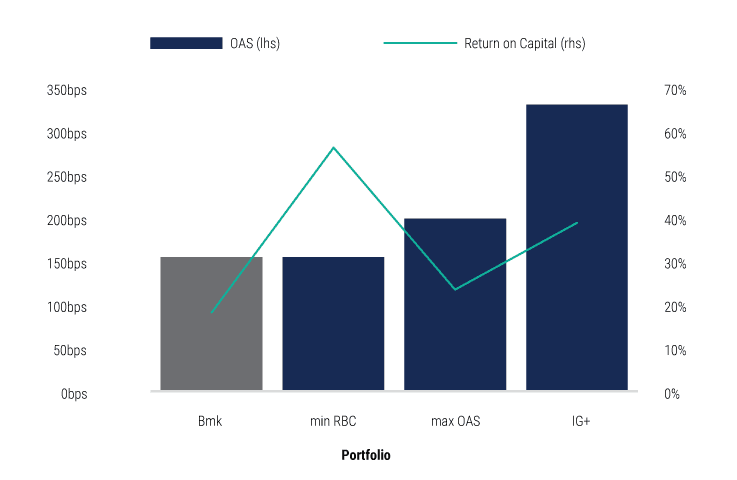
Source: JPMorgan CEMBI Broad Diversified Investment Grade (CEMBI BD IG) Index constituents as of 21 February 2023; Bloomberg, PineBridge Investments analysis and interpretation. “Bmk” is the benchmark CEMBI BD IG index; “max OAS” is the spread-maximizing portfolio; “min RBC” is the capital-saving portfolio. Return on capital is the ratio of OAS to risk-based capital.
Figure 2: Capital-Efficient Hard-Currency Investment-Grade EM Debt Portfolios by RBC Regime vs. Benchmark
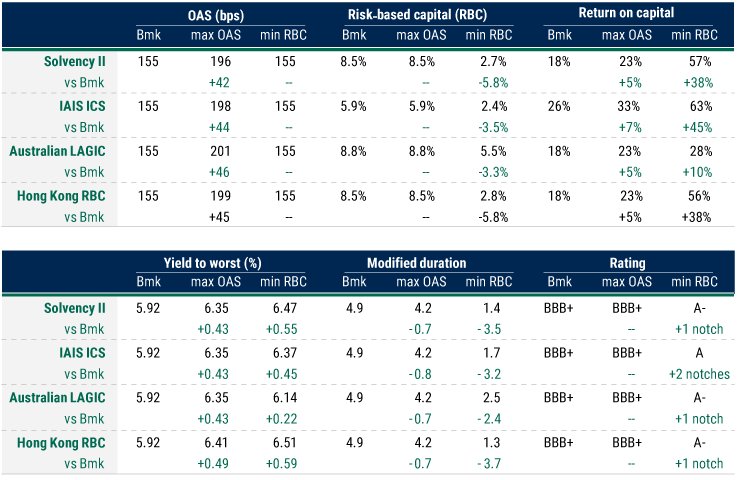
Source: JPMorgan CEMBI Broad Diversified Investment Grade (CEMBI BD IG) Index constituents as of 21 February 2023; Bloomberg, PineBridge Investments analysis and interpretation. “Bmk” is the benchmark CEMBI BD IG index; “max OAS” is the spread-maximizing portfolio; “min RBC” is the capital-saving portfolio. Risk-based capital (RBC) is PineBridge Investments’ estimate of portfolio capital requirement for credit spread risk (for Solvency II, LAGIC, Hong Kong RBC) or the post-diversification capital requirement for non-default spread risk and credit risk (for IAIS ICS). Return on capital is the ratio of OAS to risk-based capital.
Expanding the universe: the impact of allocating to high-yield debt
Replacing rigid credit quality constraints with the more flexible requirements of a risk-based capital budget improves the return on required capital. Even a modest allocation to high-yield bonds provides a significant increase in expected return on capital while maintaining the overall investment-grade quality of the portfolio. The expanded investment universe could provide portfolio managers with additional opportunities to generate alpha through active security selection and to deliver improved client outcomes.
Figure 3 illustrates the impact of allowing an allocation of up to 15% to high yield bonds while keeping the overall level of portfolio risk (as measured by risk-based capital) constant. The spread on capital-efficient “IG+” portfolios is more than double that of the investment-grade benchmark, while the RBC requirement is unchanged – resulting in a significant increase in return on capital.
Figure 3: Capital-Efficient Hard-Currency EM Debt Portfolios With Up to 15% Allocation to High Yield by RBC Regime vs. Benchmark
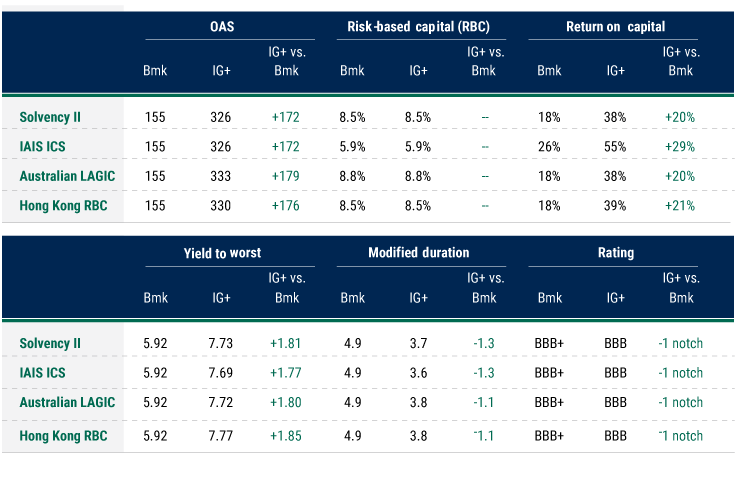
Source: JPMorgan CEMBI Broad Diversified Investment Grade (CEMBI BD IG) Index constituents as of 21 February 2023; Bloomberg, PineBridge Investments analysis and interpretation. “Bmk” is the benchmark CEMBI BD IG index; “IG+” is the spread-maximizing portfolio with 15% allocation limit for high yield bonds. Risk-Based Capital (RBC) is PineBridge Investments’ estimate of portfolio capital requirement for credit spread risk (for Solvency II, LAGIC, Hong Kong RBC) or the post-diversification capital requirement for non-default spread risk and credit risk (for IAIS ICS). Return on capital is the ratio of OAS to risk-based capital.
One size would not fit all: the capital regime drives portfolio composition
Emerging market debt portfolios – and insurers’ investments more broadly – should be tailored to the requirements of the specific risk-based capital regime. Under a one-size-fits-all approach, insurers canend up carrying the dead weight of additional capital requirements without fully utilizing that capital.
To what extent does the specific RBC regime drive the composition of capital-efficient portfolios? Figure 4 tabulates the proportion of overlapping holdings in capital-efficient portfolios constructed under the two objectives and four regimes. The divergence in composition is significant for spread-maximizing portfolios (for most pairs of regimes, 30%-40% of portfolio holdings are specific to each regime) and is even more pronounced for capital-saving portfolios (with up to 85% of non-overlapping holdings for Hong Kong RBC). This divergence would lead to significant differences in portfolio performance and in insurers’ return on capital.
Figure 4: Holdings Overlap in Capital-Efficient EM IG Corporate Debt Portfolios Under Alternative RBC Regimes
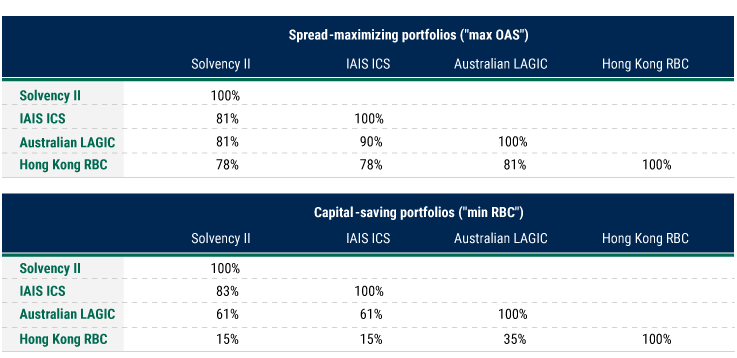
Source: PineBridge Investments analysis. The proportion of overlapping holdings between two portfolios is the sum across all instruments of the minimum of the portfolio weight of each instrument in each of the two portfolios.
The divergence is particularly important for internationally active insurance groups seeking to optimize capital allocation across the group. These groups must navigate portfolio construction under the group-wide regime (and, for the largest groups, under the IAIS ICS) alongside the local regimes applicable to their business units.
Why use capital-efficient security selection for emerging market debt?
The universe of emerging market corporate bonds is more heterogenous than that of developed market corporates. It can offer greater opportunities to improve expected portfolio performance through active security selection supported by numerical optimization.
How heterogeneous is the emerging market bond universe? Figure 5 tabulates the characteristics of the developed market (DM) and emerging market (EM) US dollar investment-grade corporate bond universes. For the DM universe, summary statistics are first reported for the full universe (“All Durations”) and then for a subset with a median duration equal to that of the EM universe (“Short Durations”).
Figure 5: Developed Market and Emerging Market Investment Grade Corporate Bond Universe Characteristics
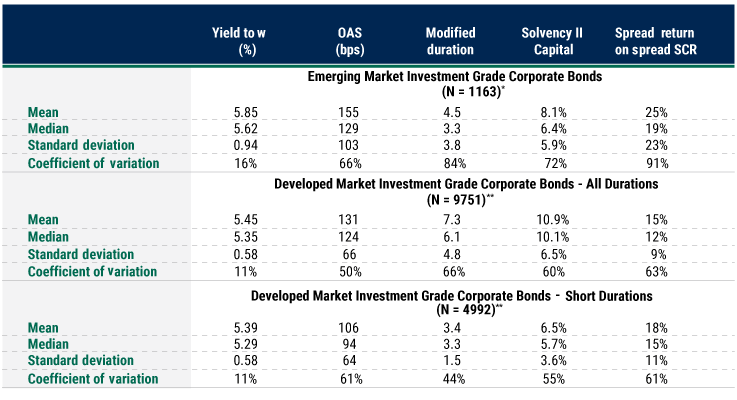
Source: *ICE BofA US Corporate Index (C0A0) constituents as of 17 February 2023; **Investment grade corporate constituents of J.P. Morgan CEMBI Broad Diversified Index as of 17 February 2023. PineBridge Investments interpretation and analysis. Excludes bonds with zero or negative modified duration or OAS. Mean is the simple average across all instruments. Standard deviation is the sample standard deviation. Coefficient of variation is the ratio of standard deviation to mean. Yield to worst, OAS, and modified duration for constituent bonds are reported by data providers. Solvency II Capital is the standard formula spread risk capital charge estimated by PineBridge Investments based on durations and ratings of constituent instruments. Return on capital is the ratio of OAS to Solvency II Capital. SCR – solvency capital requirement.
On average, the EM universe offers higher spreads and higher returns on regulatory capital. It is also more heterogeneous than the DM universe, with greater variation in yields, option-adjusted spreads (OAS), duration, regulatory capital requirements (in this case Solvency II), and returns on capital – and even more so when adjusting for the difference in median duration between the EM and DM universes.
Active capital-efficient security selection is more impactful in EM portfolio construction. The DM universe shows a closer alignment between bond spreads and capital requirements, with 36% of the spread variation explained by the Solvency II Capital – compared to 24% for the EM universe (see Figure 6).
Figure 6: Developed Market and Emerging Market Investment Grade Corporate Bond Universe Solvency II Spread SCR and OAS
Developed Market Investment Grade Corporate Bonds – Short Durations*
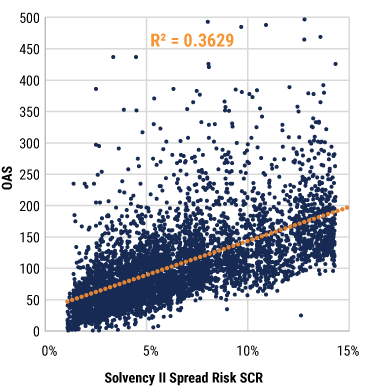
Emerging Market Investment Grade Corporate Bonds**
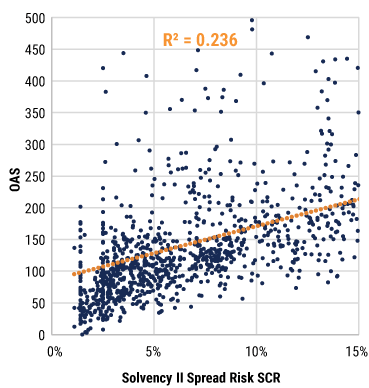
Source: *Subset of ICE BofA US Corporate Index (C0A0) constituents as of 17 February 2023 with modified duration to worst of up to 6.3 years; **Investment grade corporate constituents of J.P. Morgan CEMBI Broad Diversified Index as of 17 February 2023. PineBridge Investments interpretation and analysis. Excludes bonds with zero or negative modified duration or OAS. Solvency II spread risk solvency capital requirement (SCR) is estimated by PineBridge Investments.
We believe tailored, capital-efficient portfolios of hard-currency investment-grade EM debt may be attractive to insurers across various RBC regimes – and the addition of high yield bonds may enhance the benefits if a risk-based capital budget can replace strict investment-grade-only asset requirements. We view an active, forward-looking approach that is supported (but not replaced) by quantitative portfolio optimization as the most effective way to tap this investment universe for insurers.
Footnotes
1 JPMorgan CEMBI Broad Diversified Investment Grade Index.
2 ICS is currently in its monitoring period for IAIGs and is expected to commence as a prescribed capital requirement for IAIGs in 2024 Q4. The ICS framework is the foundation for the new risk-based capital regime in South Korea (K-ICS, commenced on 1 January 2023) and the risk-based capital regimes that are being tested in Japan (ESR) and Taiwan (T-ICS) ahead of scheduled implementation in 2026.
3 LAGIC framework is also expected to commence for Australian private health insurers on 1 July 2023
4 Hong Kong RBC is early adoption phase as of 2023, full commencement is expected in 2024
5 Or, in the case of credit risk capital requirement under IAIS ICS, effective maturity
Disclosure
Investing involves risk, including possible loss of principal. The information presented herein is for illustrative purposes only and should not be considered reflective of any particular security, strategy, or investment product. It represents a general assessment of the markets at a specific time and is not a guarantee of future performance results or market movement. This material does not constitute investment, financial, legal, tax, or other advice; investment research or a product of any research department; an offer to sell, or the solicitation of an offer to purchase any security or interest in a fund; or a recommendation for any investment product or strategy. PineBridge Investments is not soliciting or recommending any action based on information in this document. Any opinions, projections, or forward-looking statements expressed herein are solely those of the author, may differ from the views or opinions expressed by other areas of PineBridge Investments, and are only for general informational purposes as of the date indicated. Views may be based on third-party data that has not been independently verified. PineBridge Investments does not approve of or endorse any republication of this material. You are solely responsible for deciding whether any investment product or strategy is appropriate for you based upon your investment goals, financial situation and tolerance for risk.


